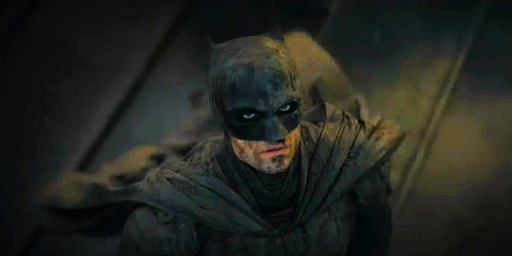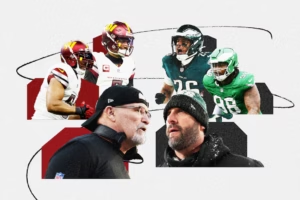Review: The Batman Centerpiece of A Neo-Noir Epic

Photo Courtesy of Warner Bros.
By Dean Robbins
Gotham is a city seemingly always covered in a thick layer of grime. Even if it rains every other day, nothing is able to wash it all away. When the sun goes down, crime becomes the local pastime while the politicians and law enforcers burn hours away in places they should not be. Watching over it all is the Batman (Robert Pattinson). His presence instills fear in every lowlife, cowering in anticipation of him leaping out of the shadows. He is also relatively new to this–only two years into his “project.”
Pattinson’s Bruce Wayne alter ego is like a vampire, repelled by daylight and ever-dour. His home is a near-comical prison of gothic architecture. The philanthropy and playboy attitude of Wayne from past iterations is gone. Wayne, in his continued grief from the murder of his parents, has retreated away from public life, focusing entirely on his covert crime-fighting. Bruce Wayne is effectively Batman’s alter ego, not the other way around.
The film wastes little time getting into its central mystery: a brutal Jigsaw-like serial killer called the Riddler (Paul Dano) is carving up Gotham’s leaders and exposing their corruption. Batman and his GCPD ally Detective Jim Gordon (Jeffrey Wright) investigate the murders and find themselves tumbling into a web of perversity and duplicity. Batman quickly finds himself in dangerous company with Selina Kyle a.k.a. Catwoman (Zoe Kravitz), mob boss Carmine Falcone (John Turturro), and Iceberg Club owner the Penguin (an unrecognizable Colin Farrell).
The unraveling of the mystery itself is not particularly surprising in its twists and turns. However, viewers are finally able to see one of Batman’s most underappreciated talents: being the world’s greatest detective. This focus on crime-solving makes The Batman likely the biggest-budgeted noir film of all time. Noir films are crime dramas that tend to be pitch-black in tone and morally ambiguous. Director Matt Reeves’ three-hour DC Comics epic checks all of these boxes.
The entire cast is incredible. There is a very legitimate case for Pattinson being the best Batman to date. Wright’s Jim Gordon is pitch-perfect, bringing both a lived-in feeling to the character as well as carrying most of the film’s rare comedic moments. The villains are adequately creepy, from Dano’s horror movie-level, bone-chilling Riddler to Farrell’s over-the-top and perfectly grotesque Penguin. Kravitz seems born to play Catwoman, lending the role raw strength and a sensuality rare in contemporary blockbusters.
Gotham and its many residents are brought to appropriately dim life by Dune cinematographer Greig Fraser’s visual constructions. If possible, see this film in IMAX to get the most detail out of the literally dark imagery. The color palette is predominantly black and red, as teased by the pre-release marketing. Fraser and editors William Hoy and Tyler Nelson stray away from technical flourishes, committing to a realism that makes the action set pieces bracingly white-knuckle in their intensity.
For many readers, this review can end here. The Batman is, by all accounts, an above-average comic book movie. It is smart, well-directed, well-acted, and sufficiently engrossing enough to make the three hours pass by quickly. Most viewers will leave the theater satisfied. Yet, The Batman left a little nagging emptiness in me after I finished the film. As I have worked on composing this review and going through several drafts, that nagging “brain itch,” to quote The Empty Man (2020), has only grown. The Batman is missing something.
Even if the story ultimately ends on a hopeful note, the outlook is relentlessly cynical. An attempt at pushing through this cynicism does not fully work, as the film’s desire to be a franchise counters its own message. The film is thematically a coming-of-age story, showing how Batman evolves and matures his vigilante philosophy. It is about a shift from vengeance and fear to hope and proactivity.
In the film’s conclusion, Batman is positioned as a savior, a light in the darkness, for the city. However, Batman is a savior for a world without a true raison d’etre (reason for existing), a genuine telos. Gotham is New York City. Gotham is London. Gotham is the overgrown shadowed part of your driveway. A functional Gotham is not the same place. Therefore, the film’s hope is ultimately defeated in the screenplay’s own definitions.
The hope of Gotham is contained in the right political candidate or a carefully managed charity or in an individual’s change of philosophy. Batman’s real transformation is from a vengeful vigilante to an agitprop figurehead. In the film’s quest for realism, the screenplay managed to both demythologize the character and make him into a politician.
God is dead in Gotham. A scene, which was officially released online prior to release, depicts a funeral taking place in an old Gothic building reminiscent of a cathedral. The building is empty, a menagerie of brooding aesthetics but not a church. There is a platform where an altar would be but there is no altar and certainly no cross. It is design without the ontology that makes design art. Despite that, the music of the scene is a choir singing “Ave Maria.” The song pops up several times in the film, but is reduced to a symbol of lost innocence, a song once beautiful that had become a reminder of pain and trauma (yes, that is an explicit plot point).
If the divine was ever present in Gotham, it was extinguished a long time ago. There is nothing truly transcendent or beautiful in this film. Joker, being one of the darkest Hollywood films ever made, is still filled with moments of beauty: the young boy on the bus or, even in all its disturbed insanity, Arthur’s dance in the bathroom. The Zack Snyder DC films spent, often to their own detriment, much of their runtimes on long montages of these moments.
After this discussion, the question may come down to: why does it matter? The Batman is a comic book movie. Who cares? Most viewers will not. With that acknowledged, Reeves is intentionally trying to deconstruct the character and the writers have stripped away every fictional eccentricity from the comics possible to remove without it no longer being a Batman movie. Superheroes have been viewed by some as new modern mythology– characters being the evolution of Theseus, Odysseus, and the like. Furthermore, a creative recreates myth and culture into an image intended to be a product of its moment. If The Batman is our culture’s reimagination of its myth, something is deeply wrong.






